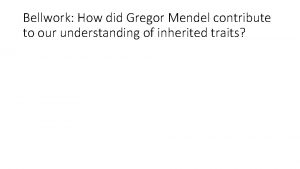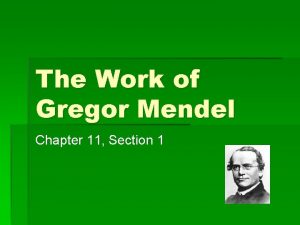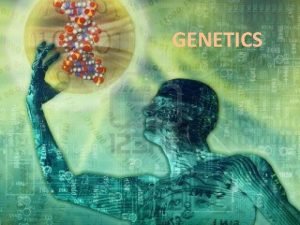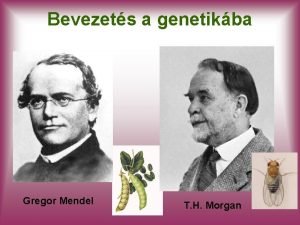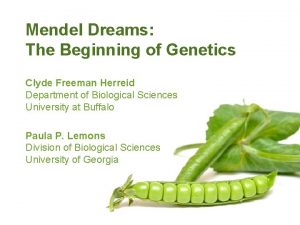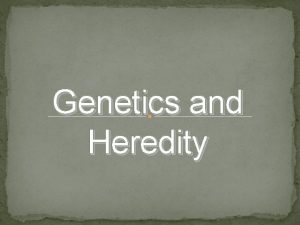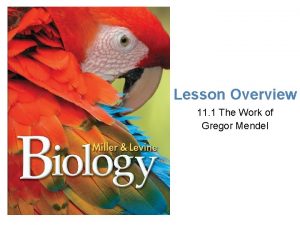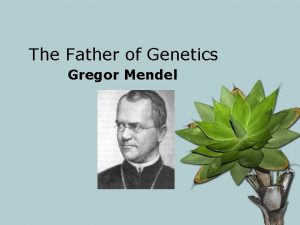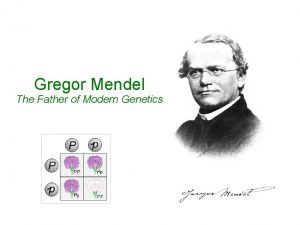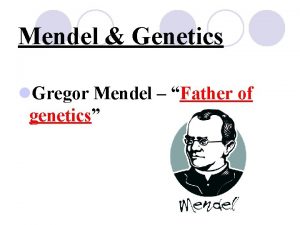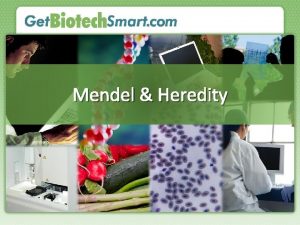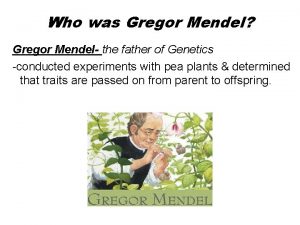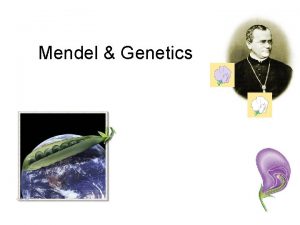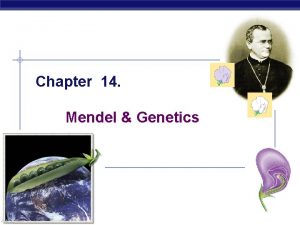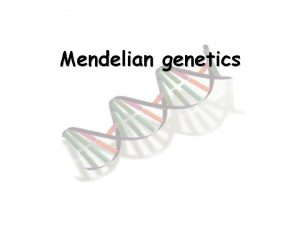Genetics Gregor Mendel the father of modern genetics











- Slides: 11

Genetics Gregor Mendel - the ‘father’ of modern genetics

Mendel applied new science of Statistics to his observations l Heredity - transmission of traits, parents to progeny l P 1 - parental generation l F 1 - first ‘filial’ generation l F 2 - second filial generation l Filial = son

Mendel crossed two pure plants - green and yellow F 1 - all yellow; F 2 - all green

Dominant trait = that which appears in the 1 st generation Recessive trait = that which reappears in the 2 nd generation not known to Mendel genes and alleles

Mendel’s conclusions 3 principles 1) dominance & recessiveness 2) Segregation - each reproductive cell receives only one ‘factor’ for each characteristic. The 2 factors for each trait segregate/separate during formation of eggs and sperm. 3) Independent assortment - ‘factors’ for different characteristics not connected. They distribute independently to the reproductive cells. Mendel’s work sat on the shelf for 35 years! He did not know about mitosis and meiosis. His work was ‘rediscovered’ in 1902.

What do we now know? Genes - segments on a DNA strand (chromosome) that controls a particular hereditary trait (thru production of a particular protein). Chromosomes - occur in pairs - genes occur in pairs. Each contrasting form of a gene is an allele Alleles represented by letters upper case = dominant allele (A) lower case = recessive allele(a) Co-dominance Incomplete dominance

http: //highered. mcgraw-hill. com/sites/0072495855/student_view 0/chapter 28/animation__how_meiosis_works. html Gametes (egg & sperm) each receive one allele an individual receives one allele for each trait from each parent Genotype - genetic makeup of an organism Phenotype - external, physical appearance of an individual. Examples genotypes phenotypes TT tall Tt tall tt short

Homozygous - both alleles for one trait are the same. May be dominant or recessive. Heterozygous - alleles are different. Some traits have multiple alleles (more than two) i. e. - blood types, ABO blood groups

Probabilities = # of one kind of event number of all events rule of addition rule of multiplication

Monohybrid crosses single trait inheritance - cross between individuals involving a contrasting trait. Punnett square helps predict probabilities.

Homozygous (dom. ) x homozygous (rec. ) TT x tt Homozygous (dom. ) x Heterozygous TT x Tt Heterozygous x Heterozygous Tt x Tt
 Father of genetics
Father of genetics How did gregor mendel contribute to genetics
How did gregor mendel contribute to genetics Chapter 11 biology review answers
Chapter 11 biology review answers Who is gregor mendel and what did he do?
Who is gregor mendel and what did he do? Chapter 11 the work of gregor mendel
Chapter 11 the work of gregor mendel Gregor mendel conclusions
Gregor mendel conclusions Fr gregor mendel
Fr gregor mendel Gregor mendel's dream was to?
Gregor mendel's dream was to? Gregor mendel video
Gregor mendel video Gregor mendel summary
Gregor mendel summary Gregor johann mendel
Gregor johann mendel Al cruzar una planta de guisantes de flores purpura
Al cruzar una planta de guisantes de flores purpura

